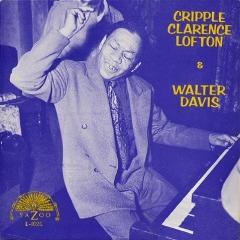Cripple Clarence Lofton & Walter Davis (1970)
Cripple Clarence Lofton & Walter Davis (1970)

A1 Cripple Clarence Lofton – Juke Joint Stomp A2 Cripple Clarence Lofton – I Don't Know A3 Cripple Clarence Lofton – State Street Blues A4 Cripple Clarence Lofton – Change My Mind Blues A5 Cripple Clarence Lofton – Streamline Train A6 Cripple Clarence Lofton – South Side Mess Around A7 Cripple Clarence Lofton – Brown Skin Girls (1935) B1 Walter Davis – Why Should I Be Blue (1940) B2 Walter Davis – Santa Claus (1935) B3 Walter Davis – Jacksonville Part 2 (1936) B4 Walter Davis – Call Your Name (1939) B5 Walter Davis – Please Don't Mistreat Me (1940) B6 Walter Davis – I Can Tell By The Way You Smell (1935) B7 Walter Davis – Can't See Your Face Cripple Clarence Lofton, Walter Davis – piano, vocals Big Bill Broonzy – acoustic guitar
Cripple Clarence Lofton is one of those colorful names that adorned many an album collection of early boogie-woogie piano 78s in the early days of the '60s folk-blues revival. An early practitioner of the form, along with his fellow contemporaries Cow Cow Davenport, Meade "Lux" Lewis, Pine Top Smith, and Jimmy Yancey, Lofton was one of the originators who spread the word in Chicago in the early '20s.
The physically challenged nicknamed he used -- seen by modern audiences as a tad exploitative, to say the least -- was a bit of a ringer. Although he suffered a birth defect in his leg that made him walk with a pronounced limp, it certainly didn't stop him from becoming an excellent tap dancer, his original ticket into show business. He quickly developed a stage act that consisted of pounding out the boogie-woogie on the piano while standing up, dancing, whistling, and vocalizing while -- as one old bluesman put it -- "carrying on a lotta racket." Lofton's technique -- or lack of it -- stemmed more from a tent show background and those listening to his earliest and most energetic recordings will quickly attest that hitting every note or making every chord change precisely were not exactly high priorities with him. But this wild, high-energy act got the young showman noticed quickly and by the early '30s, he was so much a fixture of Chicago night life firmament that he had his own Windy City nightclub, the oddly named Big Apple. Lofton remained on the scene, cutting sides for the Gennett, Vocalion, Solo Art, Riverside, Session, and Pax labels into the '40s. When the boogie-woogie craze cooled off and eventually died down in the late '40s, Lofton went into early retirement, staying around Chicago until his death in 1957 from a blood clot in the brain. ---Cub Koda, Rovi
While never a contemporary superstar or latter-day legend on a par with many of his peers, singer/pianist Walter Davis was among the most prolific blues performers to emerge from the pre-war St. Louis scene, cutting over 150 sides between 1930 and 1952. Born March 1, 1912 in Grenada, Mississippi, Davis' two-fisted piano style bore the heavy influence of Leroy Carr, although he was better known for his funereal vocal style. He first attracted attention upon relocating to St. Louis during the mid-'20s, and soon made the first of his many recordings for the Victor label. Despite its abundance, his work -- much of it recorded in conjunction with guitarist Henry Townsend -- was solid but unspectacular, eclipsed by the likes of associates including Roosevelt Sykes and Peetie Wheatstraw. Still, he enjoyed a fair amount of success before a stroke prompted him to move from music to the ministry during the early '50s. Davis was still preaching at the time of his death on October 22, 1963. ---Jason Ankeny, Rovi
download: uploaded anonfiles mega 4shared mixturecloud yandex mediafire ziddu








